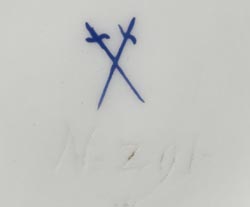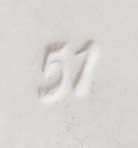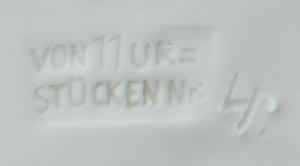Značení a číslování Meissen® porcelánu
MARKINGS AND NUMBERING OF MEISSENER PORZELLAN®
Before the definitive introduction of the blue swords mark various markings were made: Merkurstab- and Drachenmarken, pseudo-Chinese marks. Since 1722, the "crossed blue swords" were used as trademarks. Besides there were many markings.

"Johanneums" number:
From 1721 all porcelains of the Royal Collection in the Japanese Palace in Dresden were marked with engraved, sometimes only painted, signs. "Johanneum number", since the collection was kept in the 19th century in the Johanneum in Dresden (a building named after King John of Saxony). (N = followed by a one to three digit Arabic number)
Monogram brands:
Ligatur aus A und R = Augustus Rex
Ligatur aus F und A = Kurfürst Friedrich August II. (1733)
K.P.M. = Königliche Porzellan-Manufaktur
M.P.M. = Meissener Porzellan-Manufaktur
K.P.F. = Königliche Porzellan-Fabrik
K.S.P.M. = Königlich Sächsische Porzellan-Manufaktur
Owner brands:
K.C.P.C. = Königlich-Churfürstliche Pillnitzer Conditorei
K.H.C. = Königliche Hof-Conditorei
K.H.C.W. = Königliche Hof-Conditorei Warschau
K.H.K. = Königliche Hof-Küche
K.H.K.W. = Königliche Hof-Küche Warschau
K.P.C. = Königliche Pillnitzer Conditorei
K.P.K. = Königliche Pillnitzer Küche
K.S.C. = Königliche Silber-Cammer
C.H.C. = Churfüstliche Hof-Conditorei
C.H.K. = Churfürstliche Hof-Küche
C.P.C. = Churfürstliche Pillnitzer Conditorei
The "crossed swords":
The first inspector of the manufactory, Johann Melchior Steinbrück submitted in 1722 the proposal to use the Kurschwerter from the Saxon spa coat of arms to mark Meissen Porcelain®. The swords mark is one of the oldest used today and most well-known mark of the world. The crossed swords wrote brand history. The swords mark painted in underglaze blue comes in many different shapes and sizes. They were pressed in on red stoneware and later on biscuit pots. Glazed porcelains carry the blue-painted swords under the glaze on the underside of the object.
1722-1762:
For technical reasons, the underside of the base or the base was often left unglazed in early models. However, the unglazed sherd only weakens the blue, so that early models often have no or only an indistinctly visible brand. Therefore the brand of swords was applied to the rear or to the lower edge of the base underneath the glaze from 1745 until 1750, usually in a tiny small format and therefore strongly blended.
1763-1823:
Often (but not regularly!) One point was added to the swords between 1763-1773. Under the direction of Count Marcolini, a star was added to the swords between the handles, and the stamped or engraved triangular mark with the swords (sometimes with a star on the tip) was used to mark the unglazed biscuit goods. 1817-1824 the Blaumaler added Roman numbers "I" and "II" to the swords (composition of masses)
Often (but not regularly!) One point was added to the swords between 1763-1773. Under the direction of Count Marcolini, a star was added to the swords between the handles, and the stamped or engraved triangular mark with the swords (sometimes with a star on the tip) was used to mark the unglazed biscuit goods. 1817-1824 the Blaumaler added Roman numbers "I" and "II" to the swords (composition of masses)
1824-1923:
Between 1824 and circa 1850, the stamps were painted quite negligently. This quarter of a century is therefore referred to as a so-called "lubrication period". These mostly relatively small swords from the first half of the 19th century are often difficult to distinguish from those of the 18th century and are occasionally confused with the stamps of the period around 1730-1740. Around 1850, the swords were created with slightly curved blades and a point as a pommel at each end of the handle (referred to by the trade as "Knauf-Schwerter").
Between 1824 and circa 1850, the stamps were painted quite negligently. This quarter of a century is therefore referred to as a so-called "lubrication period". These mostly relatively small swords from the first half of the 19th century are often difficult to distinguish from those of the 18th century and are occasionally confused with the stamps of the period around 1730-1740. Around 1850, the swords were created with slightly curved blades and a point as a pommel at each end of the handle (referred to by the trade as "Knauf-Schwerter").
From 1924:
Under the direction of Max Adolf Pfeiffer, 1924-1934, the swords carried a point between the tips. 1945-1947, the two swords were connected by a bow below. From 1947 uniform and slightly inwardly curved swords are in use.
"Onion Pattern":
In order to make the underglaze blue onion pattern decoration of the Meissen® manufactory easily distinguishable from the many imitations that have been produced since the middle of the 19th century and still are today, the swords have been repeated in the decor since 1888.
White goods:
Starting from 1919 one characterized white goods, which should receive in principle no colored decoration, with a blind postmark: swords over writing "white"
Underglaze blue decoration at the edge of the underside starting from 1950:
1951-1953 a point below the swords mark
1953-1957 a vertical line below the swords mark
1957-1972 a horizontal line below the swords mark
1972-1980 a vertical line next to the swords mark
From 1980 a horizontal line next to the swords mark
In addition to the crossed pair of swords are various markings of press marks, incised marks, painter numbers, anniversary stamps and special signs:
BOSSIERER (Repairer's)-number:

It is an arabic numeral of up to three figures that is stamped while the porcelain is leather-hard. It is assigned to a specific Bossierer and serves the production control. The Bossierer puts the individual pieces of the figure together.
Year-marks:

From 1948, a year sign is added to the Bossierer number. Initially in geometric form, from 1980 in alphabetical form, the letters I, Q, U, V, X, Y, Z were left out. There is an A and B for 1999. Irregular letter connections are given since 2000.
Shape number (model number):
The indicator under which the model is registered. The number is engraved on the underside or sometimes laterally engraved or incised. At the beginning the manufactory gave single-digit to four-digit numbers (1-3000), starting from 1764 in alphabetical order (A 1 - Z 99), from 1851 followed the second alphabet (A 100 - Z 300), (since the letter T was given irregularly) After 1973 all model numbers were replaced by a five-digit Arabic number (50001-99999), currently the manufactory uses a code with a letter-number combination (for example: 90M36) Attention! All registers contain irregularities and changes. Some models have been modified or deleted and the number has been re-assigned. In some cases, different models have the same form number. With manually scribed alphabetic model numbers, the old spelling can easily lead to confusion of some letters (B and R, L and S, V and Y, H and X etc.)
The models from foreign artists indented by the manufactory have been provided with the letter A and a four-digit number starting with A1001 as of 1924 in order to distinguish them from manufactured in-house models which were still registered in the old order.
This new regulation was retroactive: models that had been purchased before 1924 and had received an old number, now got the new A-number with four-digit number. There are a total of 300 models with A numbers known (A 1001 - A 1300). For this reason, a model may have received four different shape numbers over time, for example: "Leuchter-Reiter" by Gerhard Marcks, model year: 1919, model number: F 272 (old model) Number, 1919-1923 and 1935-1972), A 1010 (Pfeiffer time, 1924-1934), 79303 (new form number for white porcelain, from 1973), 85006 (new form number for Böttger stoneware, from 1973)
Porcelain mass or paste code:

It is a character indicating the porcelain mass offset (mixing ratio of raw materials for ceramic materials). Older Böttger stoneware pieces have the paste code such as L 209, L 230 or L 241. The model number is similar to this paste code but it should not be mistaken with the paste code!
Painter Number:
an arabic numeral of up to four digits painted in colour on the underside of the object.
The painter's number is assigned to a specific painter and serves in the production control process. After 1973, it is painted on vessels immediately next to the decor number separated by a slash. Some early Blaumaler marked the pieces with their initials, some pieces with extra dots, dashes and numbers.
Decor-Number:
The decor number is assigned to certain paintings and decorations.
A six-digit arabic number separated by a slash before the painter numbers have been introduced since the 1970s. The numbers are applied either on the overglaze or in underglaze colours depending on the type of painting. An arabic numeral of up to a maximum of four-digits (possibly with additions of lowercase letters) was applied before that time.
Signatures:
Artists' and painters' signatures or monograms are very rare on MEISSEN porcelain of the 18th and first half of the 19th centuries. Later on, well-known artist's models were marked more frequently with the artist's name or monogram, ofter together with the year that the model was created. The signature or the monogram is stamped while the porcelain is leather-hard. The artist's own signature is painted in colour (over or under the glaze) or in gilding.
Artist Monograms:
E. A. = Emmerich Andresen
E P B = Emil Paul Börner
VB ligiert = Volkmar Bretschneider
AE ligiert = Andreas Ehret
OF = Olaf Fieber
E. GR. = Ernst Grämer
AK ligiert = Alfred König
RS ligiert = Rudi Stolle
PS ligiert = Peter Strang
SW = Sabine Wachs
PW ligiert = Paul Walther
HW ligiert = Heinz Werner
ZP ligiert = Ludwig Zepner

Original pieces:
The production of original pieces (artist's examples) was introduced in 1918. Original pieces bear the impressed mark "von 11 Urstücken Nr." (of 11 original pieces number), folllowed by an incised numeral indicating the number (1-11) or the piece. The mark "Von 5 Urstücken Nr." (of 5 orginal pieces number), followed by the incised number (1-5) in only rarely found.
Böttgersteinzeug® bear the stamp mark "of 55 formations No." followed by a number (1-55).
Jubilee marks in blue (underglaze):
1710 -1910: 200-Anniversary of the manufactory Meissen®
1710 - 1960: 250-Anniversary of the manufactory Meissen®
1982: Johann Friedrich Böttger to his 300th birthday
1739 - 1989: 250-birthday of the "onion plattern
2000: six different special stamps for the limited edition "ZeitZeichen"
Unique pieces:
A unique piece is created in the artistic workshops of the Meissen® manufactory without the aid of models and can not be produced in series for this reason. Unique pieces are thus unrepeatable individual pieces, signed and provided with a unique number (consecutive numbering within one year and the corresponding year). Unique pieces have been available in Meissen® since 1982.
Sondersignets in Gold (aufglasur):
1996: Johann Gregorius Höroldt Monogrammed for his 300th birthday: J. G. H.
1997: 275-Anniversary of the blue sword mark (275 in gold)
1999: Century collection (three intertwined numbers 9 and number 1)
2002: Collection "Couple-wise" (two intertwined numbers 2)
2004: Collection "Sinn-Bilder" (stylized acanthus flowers)
2006: Johann Joachim Kaendler Monogrammed for his 300th birthday: J. J. K.
2010: Anniversary Collection 300 years of manufactory Meissen®
(three intertwined numbers 300 with C, limitation number) Since 2005: Edition "Limited Masterpieces" (ligated letters LM with corresponding numbering)
Protected word marks:
from 1919 Böttgersteinzeug®
from 1972 Meissen®
from 1985 Meissener Porzellan®
Wheel-cut lines or Cancellation marks:
The different versions and applications of various periods have been described differently in the literature. In general, the following applies:
- a wheel-cut line for undecorated white goods or II. Choice
- two wheel-cut lines II. Choice
- three and four wheel cut lines III. and IV. Option (sold to manufactory employees only)

- five wheel-cut lines or two crossed wheel-cut lines for pieces that remain in the manufactory for use





